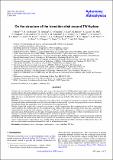Files in this item
On the structure of the transition disk around TW Hydrae
Item metadata
| dc.contributor.author | Menu, J. | |
| dc.contributor.author | Van Boekel, R. | |
| dc.contributor.author | Henning, T. | |
| dc.contributor.author | Chandler, C.J. | |
| dc.contributor.author | Linz, H. | |
| dc.contributor.author | Benisty, M. | |
| dc.contributor.author | Lacour, S. | |
| dc.contributor.author | Min, M. | |
| dc.contributor.author | Waelkens, C. | |
| dc.contributor.author | Andrews, S.M. | |
| dc.contributor.author | Calvet, N. | |
| dc.contributor.author | Carpenter, J.M. | |
| dc.contributor.author | Corder, S.A. | |
| dc.contributor.author | Deller, A.T. | |
| dc.contributor.author | Greaves, J.S. | |
| dc.contributor.author | Harris, R.J. | |
| dc.contributor.author | Isella, A. | |
| dc.contributor.author | Kwon, W. | |
| dc.contributor.author | Lazio, J. | |
| dc.contributor.author | Le Bouquin, J.-B. | |
| dc.contributor.author | Ménard, F. | |
| dc.contributor.author | Mundy, L.G. | |
| dc.contributor.author | Pérez, L.M. | |
| dc.contributor.author | Ricci, L. | |
| dc.contributor.author | Sargent, A.I. | |
| dc.contributor.author | Storm, S. | |
| dc.contributor.author | Testi, L. | |
| dc.contributor.author | Wilner, D.J. | |
| dc.date.accessioned | 2014-08-28T09:31:04Z | |
| dc.date.available | 2014-08-28T09:31:04Z | |
| dc.date.issued | 2014-04-14 | |
| dc.identifier | 143970015 | |
| dc.identifier | 97def226-9eb8-42c5-b7ac-610657445c7b | |
| dc.identifier | 84898432816 | |
| dc.identifier | 000334671000093 | |
| dc.identifier.citation | Menu , J , Van Boekel , R , Henning , T , Chandler , C J , Linz , H , Benisty , M , Lacour , S , Min , M , Waelkens , C , Andrews , S M , Calvet , N , Carpenter , J M , Corder , S A , Deller , A T , Greaves , J S , Harris , R J , Isella , A , Kwon , W , Lazio , J , Le Bouquin , J-B , Ménard , F , Mundy , L G , Pérez , L M , Ricci , L , Sargent , A I , Storm , S , Testi , L & Wilner , D J 2014 , ' On the structure of the transition disk around TW Hydrae ' , Astronomy & Astrophysics , vol. 564 , A93 . https://doi.org/10.1051/0004-6361/201322961 | en |
| dc.identifier.issn | 0004-6361 | |
| dc.identifier.uri | https://hdl.handle.net/10023/5273 | |
| dc.description | J. Menu acknowledges an FWO travel grant for a long research stay abroad (V448412N). F. Ménard acknowledges support from the Millennium Science Initiative (Chilean Ministry of Economy), through grant “Nucleus P10-022-F”. F. Ménard also acknowledges funding from the EU FP7-2011 under Grant Agreement No 284405. | en |
| dc.description.abstract | Context. For over a decade, the structure of the inner cavity in the transition disk of TW Hydrae has been a subject of debate. Modeling the disk with data obtained at different wavelengths has led to a variety of proposed disk structures. Rather than being inconsistent, the individual models might point to the different faces of physical processes going on in disks, such as dust growth and planet formation. Aims. Our aim is to investigate the structure of the transition disk again and to find to what extent we can reconcile apparent model differences. Methods. A large set of high-angular-resolution data was collected from near-infrared to centimeter wavelengths. We investigated the existing disk models and established a new self-consistent radiative-transfer model. A genetic fitting algorithm was used to automatize the parameter fitting, and uncertainties were investigated in a Bayesian framework. Results. Simple disk models with a vertical inner rim and a radially homogeneous dust composition from small to large grains cannot reproduce the combined data set. Two modifications are applied to this simple disk model: (1) the inner rim is smoothed by exponentially decreasing the surface density in the inner ~3 AU, and (2) the largest grains (>100 μm) are concentrated towards the inner disk region. Both properties can be linked to fundamental processes that determine the evolution of protoplanetary disks: the shaping by a possible companion and the different regimes of dust-grain growth, respectively. Conclusions. The full interferometric data set from near-infrared to centimeter wavelengths requires a revision of existing models for the TW Hya disk. We present a new model that incorporates the characteristic structures of previous models but deviates in two key aspects: it does not have a sharp edge at 4 AU, and the surface density of large grains differs from that of smaller grains. This is the first successful radiative-transfer-based model for a full set of interferometric data. | |
| dc.format.extent | 22 | |
| dc.format.extent | 1267039 | |
| dc.language.iso | eng | |
| dc.relation.ispartof | Astronomy & Astrophysics | en |
| dc.subject | Protoplanetary disks | en |
| dc.subject | Techniques: interferometric | en |
| dc.subject | Stars: individual: TW Hya | en |
| dc.subject | QB Astronomy | en |
| dc.subject.lcc | QB | en |
| dc.title | On the structure of the transition disk around TW Hydrae | en |
| dc.type | Journal article | en |
| dc.contributor.sponsor | Science & Technology Facilities Council | en |
| dc.contributor.institution | University of St Andrews. School of Physics and Astronomy | en |
| dc.identifier.doi | https://doi.org/10.1051/0004-6361/201322961 | |
| dc.description.status | Peer reviewed | en |
| dc.identifier.url | http://www.scopus.com/inward/record.url?eid=2-s2.0-84898432816&partnerID=8YFLogxK | en |
| dc.identifier.grantnumber | ST/J001651/1 | en |
This item appears in the following Collection(s)
Items in the St Andrews Research Repository are protected by copyright, with all rights reserved, unless otherwise indicated.

